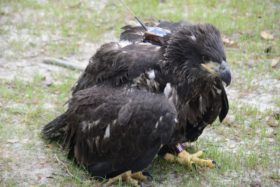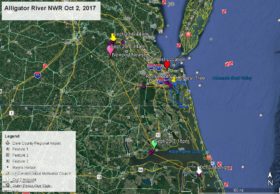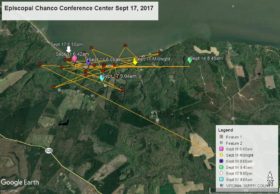Second Egg Laid Feb 6
Azalea Flies to Pasquotank County, NC
February 5, 2011Azalea Stays in Pasquotank County
February 8, 2011




In my post for the delivery of the first egg of the season on Feb 3 I wrote ” the process of forcing the egg out can take a few minutes to about a half hour or more”. The first egg took 3 minutes. The second egg took 27 minutes.
At 3:58pm today – Feb 6 – the female leaned over and began to strain. It soon became obvious that this delivery was going to be longer. Unlike the first egg delivery when the female was alone, this time the male was there, arriving at 4:04 with a fish. After much straining with the male nervously looking on and pacing about the nest, the second egg finally arrived about 4:25pm. We got the first look at 4:26, after which the male left the nest. Appearing to be completely exhausted, the female began incubating and rested for about 25 minutes then got up and took a look at her two eggs. After that she ate the fish that her mate had brought to the nest during her delivery. In the last photo, note the first egg (in back) has been stained from wet pine straw, compared to the matte white of the brand new egg.




9 Comments
Great captures Reese. Our Dad is the best …he sure does love mom 🙂
Thanks
Reese – thank you so much for your dedication. You make these eagles quite special!! Whoo hoo – egg #2!!
Thanks Reese– not only did male pace – the viewers were too 🙂 we were suprised how quickly he was by her side and stayed to the end. It was touching-pace- pick at stick- pace She ate the fish like it was a minnow.
thank you to all that accept all our questions and comments all day long. we are all in this together loving these incredible eagles at Norfolk. So many tears as we see how the wild take care of their young and their mates. If only humans could learn from them. NBG and all involved deserve such kudos for what you do so we all can enjoy this incredible experience year after year. We are all in awe!!!
Wonderful pictures! So glad the egg “delivery” went well. I had no idea it could take as long as 27 minutes. So glad Momma Eagle is ok!
I’m confused and was wondering if you would clarify something for my own knowledge base? In previous egg laying seasons we were told once the egg is laid it is allowed to cool and harden. Now we are being told, not by you, the egg is laid in it’s final form and requires no cooling period or additional hardening. I have watched several eggs laid in many nests and several minutes have passed between the laying and the female finally positioning the egg and nestling on it. Perhaps both scenarios are fact? Thank you for all you do, I appreciate it.
Response – I don’t know who or where you heard that “once the egg is laid it is allowed to cool and harden”. According to Ornithology by Frank B. Gill “Below 26 degrees C (about 80 F) the development of young embryo simply stops.” Full time incubation is delayed when more than one egg is expected in order for the eggs to hatch at a closer interval, but the eagle or other bird knows just how long she or he can leave the egg uncovered.
I don’t know how that answers my question. And in fact heard that here either in the chat or one of the links provided.
Sorry to have sought clarification, not a mistake i will make again.
Thanks for doing this again. It is fun to watch
Oh my goodness. Nothing is more precious than watching this and hearing a play by play discussion. These birds are something else. I hope that everywhere all the Eagles are successful with the process of bringing new Eaglets into the world.